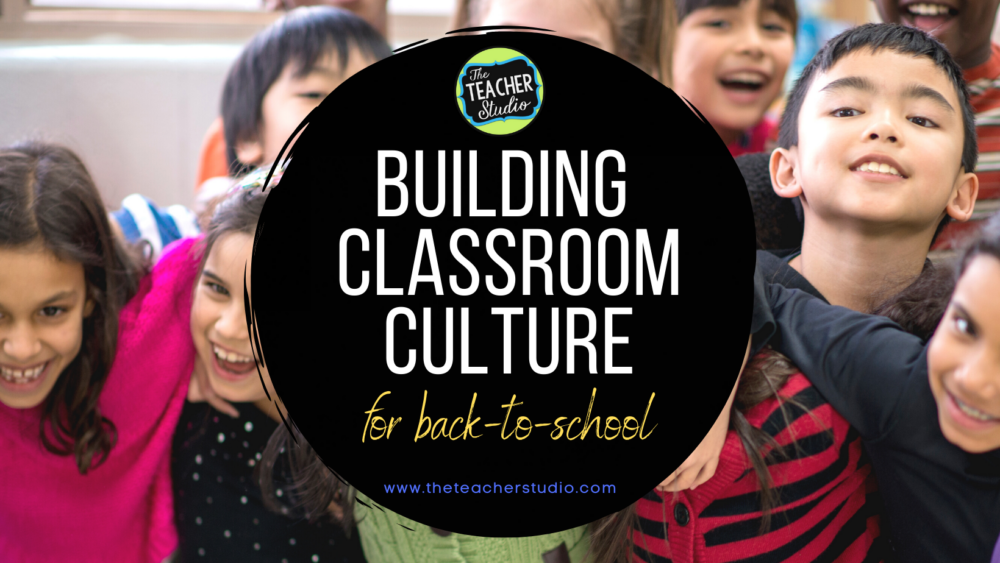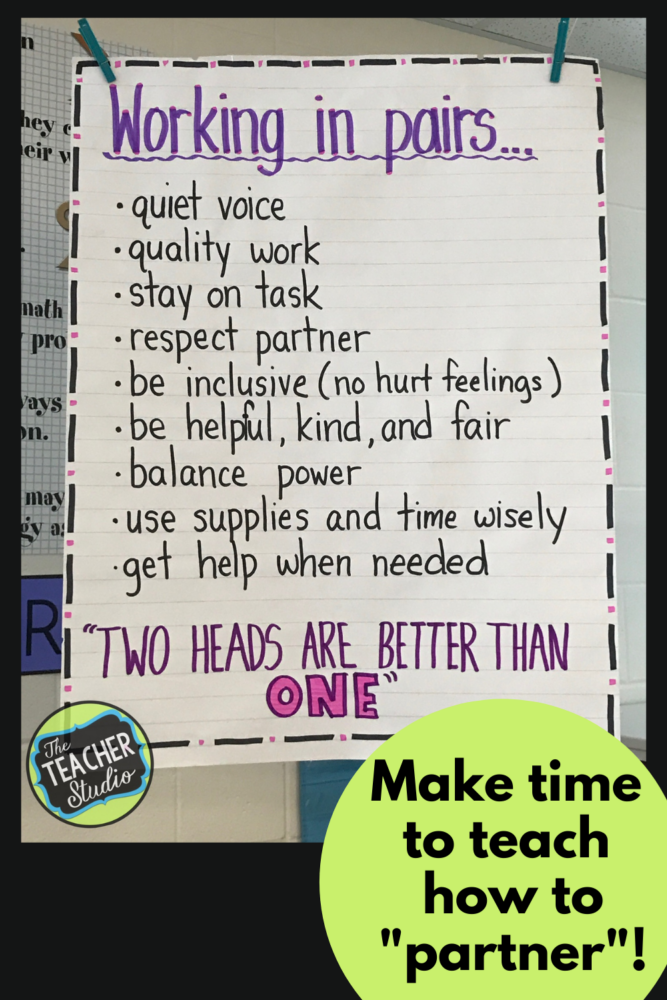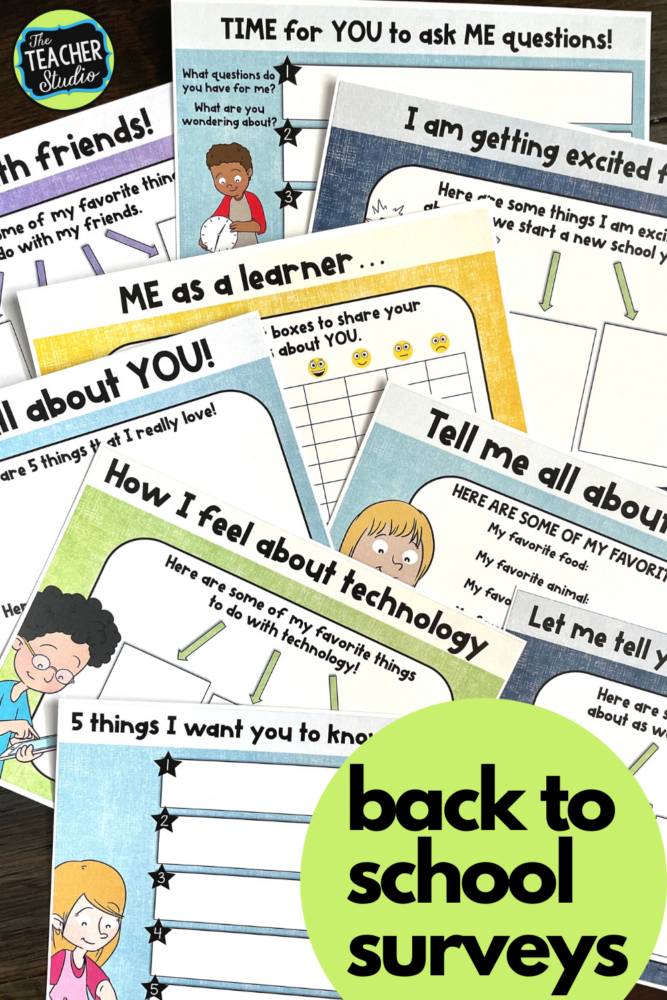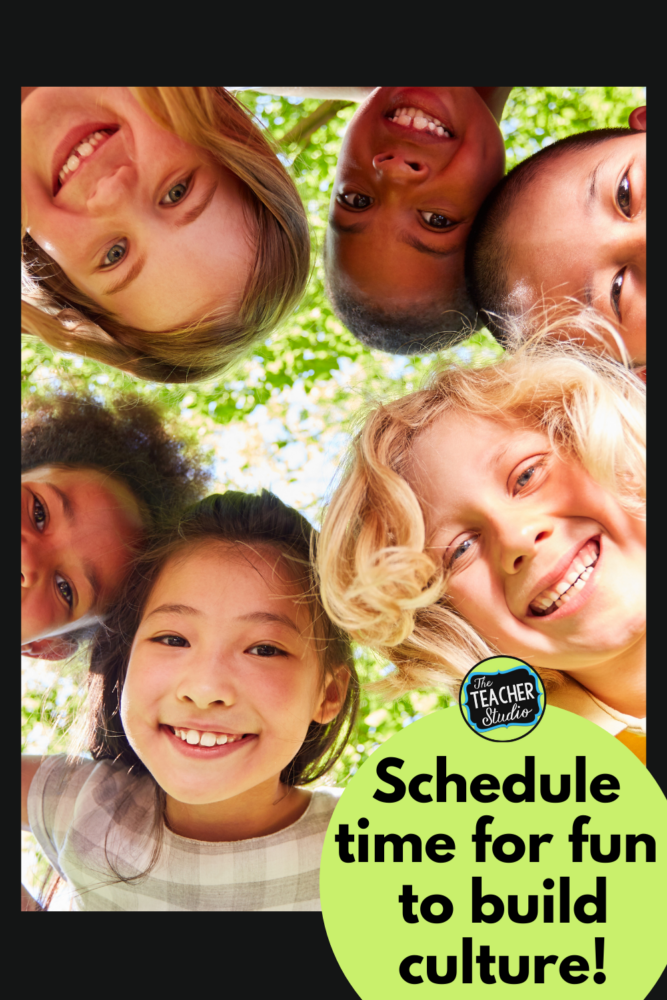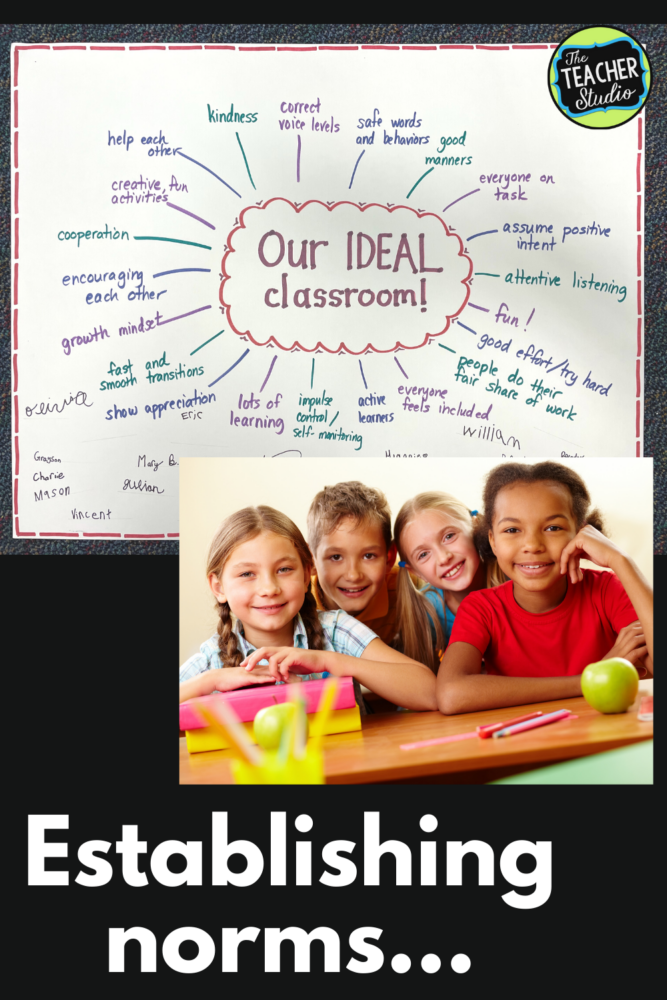Working to build classroom culture in the first weeks of school is critical. Research shows that a number of components related to classroom culture, student discussion, and more are highly correlated with academic success. Not only that, but we want our students to enjoy their time in our rooms, right? Let’s take a peek at nine strategies that will help build your classroom community and lead to success.
Work in partners first/partner expectations
It is so important for students to feel “safe” at the beginning of the year. This starts by building relationships one person at a time. There are tons of great cooperative activities that can be done to do this (CLICK HERE for some fun ones!), but often we forget to start small–with partnerships.
Consider creating an anchor chart with your class where you work together to better understand WHY we work in partners and HOW we work with partners. As always, I recommend creating your anchor charts WITH your students in rough draft format and then organizing and wordsmithing to make a final copy to display and refer to.
Provide as MANY opportunities to work in partners as possible–whether it be a quick little task, reading an article, solving a puzzle, or just doing a “get to know” you activity.
Take a survey
Getting to know our students is so important–it helps them feel like they are valued members of our class and that they matter. There are millions of ways to collect this information about students. Play a game like “That’s Me!” where you present a prompt (“Who likes pizza?”) and all students who match just up and shout “That’s me!”.
Have students vote on things like their favorite snacks…or their favorite recess games…or even what book to read next. Students love to have their voices heard, and the better we know our students, the more we can serve their needs.
I want to know as MUCH about my students as possible, so I work in small surveys throughout the first weeks to help me. I have written a series of surveys that I have used if you are interested–they are both printable and digital. Just CLICK HERE to check them out.
Opportunities for fun
This isn’t rocket science, is it? Students have just come off a summer of no schedules and few expectations. Break them in gently with fun! Whether you teach them math games as you teach them how to work in partners, tell jokes, read funny books, take extra recesses, give choice time, or share funny cartoons–budget time for fun. STEM activities, games…you know the drill. Want a great one for back-to-school? Check out my “Help Harry” lesson–and it’s free!
Yes, we have a lot to cover. Yes, we need to learn. That being said, happy students will learn more. Period.
Change activities and “learning styles” often
You know how it is at the beginning of the year. We have SO many rules and expectations to go through. It sometimes feels like all we do is lecture! Our throats even hurt by the end of the day!
Be mindful of the fact that MANY students have different learning styles. I try to always have a slide with pictures to go with my beginning of the year information. I try to alternate that kind of work with the “fun” stuff–and art projects and body movements and outside activities and science/STEM labs. Although we build our stamina throughout the year, I switch activities often at the beginning, and I really try to mix up those learning styles so everyone feels they got to do something that really interested them each and every day.
Help students learn each other’s names
This seems obvious. I know WE focus on it, but some students really have a hard time learning other students’ names. Consider wearing name tags for a few days to help. Repeat student names as often as possible. Do activities in desk groups/work times to have students REALLY get to know those several students. Ask students to use people’s names before asking them a question.
Possibly the MOST important piece of this is to learn how to pronounce each child’s name correctly–first and last. A name is a key part of an identity. Don’t overlook the importance of this. There are a number of cute books about names, but this is one more way that we can make every child feel like they are wanted and valued in our classrooms.
Establish norms and classroom culture
Students do better when they know what the expectations are…for academics AND behavior.
Although there may be some things that we need to put in place as non-negotiables (especially with respect to safety or school rules), I generally feel it’s best to work as a class to establish these norms.
Work together to create a web about what our “ideal class” would look like and feel like. EXPERIENCED TEACHER HINT: Be very clear that this does NOT mean free ice cream, 9 recesses, and a llama as a class pet! Instead, what kinds of behaviors and “norms” will make everyone feel safe and valued.
When the brainstorming is finished, work to combine ideas and group them. Create a final anchor chart and have all your students sign it. This is my version of a classroom “constitution” and we refer back to it often as the document we all agreed on to make our classroom as ideal as possible.
Celebrate the “class” as a family
This is big for me. I refer to us as a “Family” from the beginning. I remind them that we won’t always get along (like a family), but that if we can work together protect each other, and enjoy our time together–we will have a much better year.
As the year unfolds, we have to have class meetings to talk about some of our ongoing issues, but we work through them together. When members of our family are hurting, we work together to find solutions. Try to find ways to make sure your students have them safe, nurturing place to spend a huge chunk of their day. Many of them need it desperately.
Weave the procedures into the fun
Earlier I mentioned “fun”, and then also talked about establishing procedures. Sometimes the two can be woven together! One example is to design a project that lets you “teach” your expectations about something. For example, I do a back-to-school “glyph” project that has two main goals:
- To help the students get to know each other
- To establish my expectations for neatness and work quality
I build those discussions right into the directions! We generate an anchor chart of what quality work is, and then as we work, we practice and self-assess. It takes a little longer, but the results are great–and the students have tremendous pride in the final product. CLICK HERE if you want to see more about what I use for this!
[one-half-first]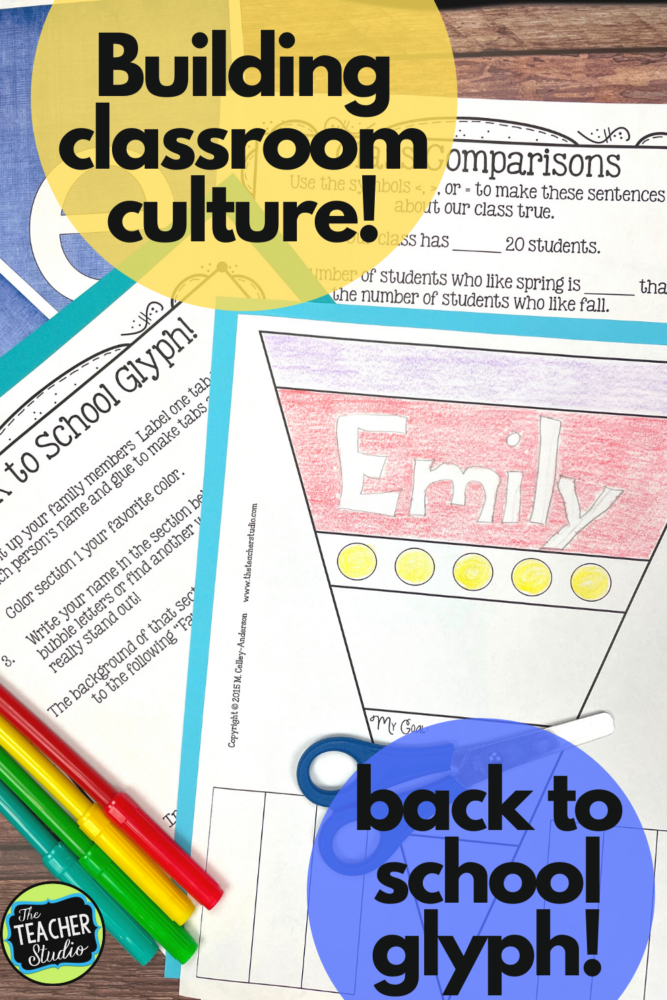 [/one-half-first]
[/one-half-first]
[one-half]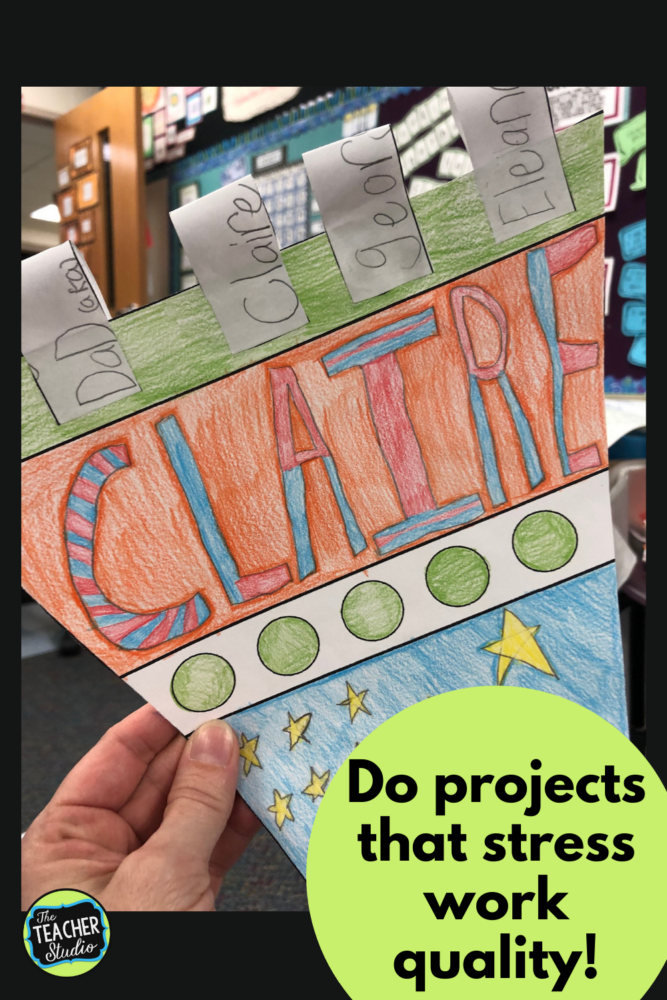 [/one-half]
[/one-half]
Practice accountable talk/etc
One final way that we can truly work to build our back-to-school culture is to make sure students have the words needed to be an active participant in class. Using accountable talk stems like:
- I agree with ___ because…
- Could you explain that a different way?
- I would like to add on to what ___ said.
- I respectfully disagree with that because….
- And so many more!
By displaying these sentence starters, we give students the tools to engage and participate. They need to be explicitly taught and practiced, so I give my students lots of low-stress opportunities in the first weeks to do that. In order to disagree with someone, there needs to be an element of trust that it will be ok to do so.
We practice with fun topics like favorite ice cream flavors and the best pet options before we dig into more meaty things related to academics. A few things that may help you if you are interested…
- A set of free accountable talk stems!
- My “accountable talk” resource with topic starters and more!
I hope these 9 ideas get you motivated to invest some quality time in building culture in your classroom. It will pay off a thousand times over! Thanks for stopping by!

